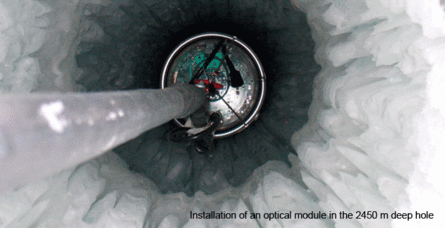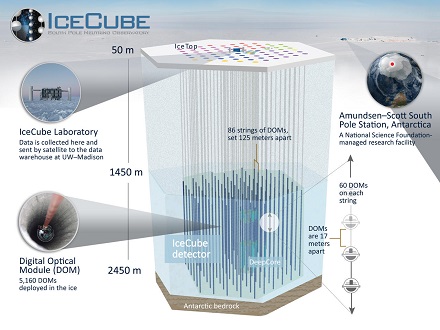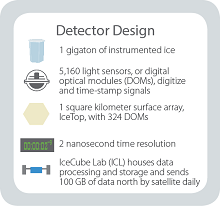IceCube is a state-of-the-art neutrino telescope at the geographical South Pole, buried deep under the surface of the Antarctic ice cap. With more than five thousand optical sensors distributed over a cubic kilometer of ice, IceCube is the biggest particle detector world-wide.
At first glance, the South Pole may appear to be a strange site for deploying such an instrument. But there are crucial advantages that outweigh the remoteness of the site. The polar ice is about 3 km deep, incredibly transparent, and the level of background light is extremely low. That makes it an ideal medium to detect the faint light signals produced in the interactions of high-energy neutrinos. The necessary on-site infrastructure is provided by the Amundsen-Scott polar station, run by the National Science Foundation of the United States.
IceCube is primarily designed to observe neutrinos from the most violent astrophysical sources in our universe. Neutrinos, almost massless particles with no electric charge, can travel from their sources to Earth with essentially no attenuation and no deflection by magnetic fields.
IceCube was constructed over 7 years from 2004 to 2011, and is fully operational since then. All cargo was transported by plane from McMurdo station located at the Antarctic coast to South Pole station. 2.5 km deep holes have been drilled in the ice using hot water at high pressure to deploy the sensors that detect the faint light from the neutrino interactions.
The in-ice component of the completed IceCube consists of 5,160 optical sensors called digital optical modules (DOMs), each one equipped with a 25cm diameter photomultiplier tube and associated electronics. The DOMs are attached to vertical cables (“strings”), frozen into the 86 boreholes, and arrayed over a cubic kilometer at depths between 1.450 meters to 2.450 meters.
Eight of these strings at the center of the array were deployed in a more compact configuration than the rest of the array. This denser configuration forms the DeepCore subdetector, which has a lower neutrino energy threshold than the main in-ice array of about 10 GeV, creating the opportunity to study neutrino oscillations.
The optical sensors of IceCube even respond to a single arriving photon. Inside the optical modules, the photon signals are amplified, converted into electrical pulses and then translated into digital signals. Therefore, each module has its own mini-computer as well as a precision clock to measure the arrival time of the photons to an accuracy of 2 nanoseconds (2*10-9sec). The digital information is then sent over kilometer-long cables to the central data acquisition system in the IceCube Lab, processed there, and shipped to the University of Wisconsin in Madison, USA, via a daily satellite link.
Neutrinos are not observed directly, but when they interact with the ice they produce electrically charged secondary particles that in turn emit Cherenkov light. The light pattern and arrival time recorded in IceCube’s sensors is used to determine the direction and energy of the incoming neutrino. This lead in 2013 to the discovery of the long sought-after cosmic neutrinos and the opening of a new field in science, the multi-messenger astronomy, where the information from photons, neutrinos and now also gravitational waves is combined to study the high-energy universe. The astrophysical sources of the neutrinos observed by IceCube are still largely unknown. However, since an observation in 2017 there is strong evidence that at least some of them are produced in the jets formed around the central black holes of active galaxies. More about this observation can be found here: https://multimessenger.desy.de/.
IceCube is operated by the international IceCube Collaboration, over 300 researchers from more than 50 institutions worldwide. The collaboration is also responsible for the rich scientific research program, which besides multi-messenger astronomy also includes many unique measurements in particle physics and searches for beyond-the-standard model particles and phenomena.
DESY hosts the second largest group in the IceCube collaboration. The group’s most important contributions to the IceCube project are:
- Production and test of 1250 of the more than 5000 optical modules
- Development and manufacturing of electronic components for the data acquisition system
- Software development for the data analysis
- Development and test of new methods of particle detection
- European TIER1 center for data archiving and analysis
- Data Analysis
Impressions from the South pole:









